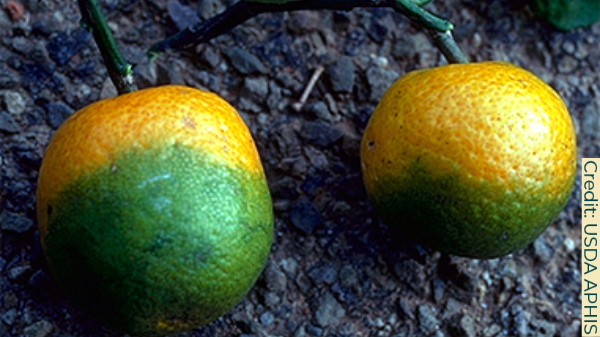Here’s another name you can add for this hated disease: California calls it huanglongbing (HLB), Florida calls it citrus greening disease, and in the Mexican state of Veracruz—the nation’s main citrus producer—it is called the yellow dragon.
In Mexico, it was first discovered in the state of Yucatan and now has expanded to the main citrus producing areas of the country. It is now ravaging Veracruz.

“Authorities and producer associations estimate that the bacteria has sickened 70 percent of the 171,000 hectares of oranges in the state. It has caused a historic drop in the annual production of Veracruz,” reports the newspaper La Jornada, La Jornada – Plague devastates orange plantations in northern Veracruz adding, “In Veracruz, authorities have failed to implement a forceful strategy to curb the spread of the disease and reduce crop deaths.”
The newspaper reports that “Oved Zúñiga Barra, who for four years was president of the Association of Citrus Growers of Castillo de Teayo, which brings together 243 producers, said: The yellow dragon is the greatest misfortune that has happened to us. An orchard that gave 30 to 35 tons of orange in good seasons, now gives 10 or 15 tons. . . . And for many, it’s barely getting six or seven tons.”
The symptoms will be familiar to those who have faced this disease in the U.S.: dry leaves, yellow spots on leaves, and irregularly shaped and flavorless fruit.
Methods of control involve fertilizer application, but that is expensive—10,000 pesos ($584 U.S.) per hectare—and prohibitive for many growers.
One grower says that HLB has been so severe because it has combined with other pests. “They all came together: there are mushrooms and Dhiaphorina in the same tree. And they are already present in all orchards. There is no one who is saved.”
If the disease is not curbed, it will create huge economic problems for the state, where 80 percent of the jobs come from the citrus industry.
“Due to this pest, a phytosanitary emergency was declared in Paraguay and national strategies were applied in Argentina to contain this citrus disease,” says La Jornada—an approach that has not yet been taken in Mexico. HLB has also been found in Spain, a major citrus producer.
The only citrus growing area of the world that appears to manage HLB is, curiously, Nepal. The disease has long been present in the Himalayan nation, but growers have kept it under control.
Christoper Vincent, University of Florida Institute of Food and Agricultural Sciences (UF/IFAS) assistant professor of environmental physiology, visited the area in July, reporting, “Where growers were using good irrigation practices and good mineral nutrition practices in terms of following local recommendations, trees really didn’t have a decline problem.” HLB Lessons Learned From Nepal – Citrus Industry Magazine
It might be a good idea to explore the Nepalese methods and see if and how they might be applied to North American conditions.



